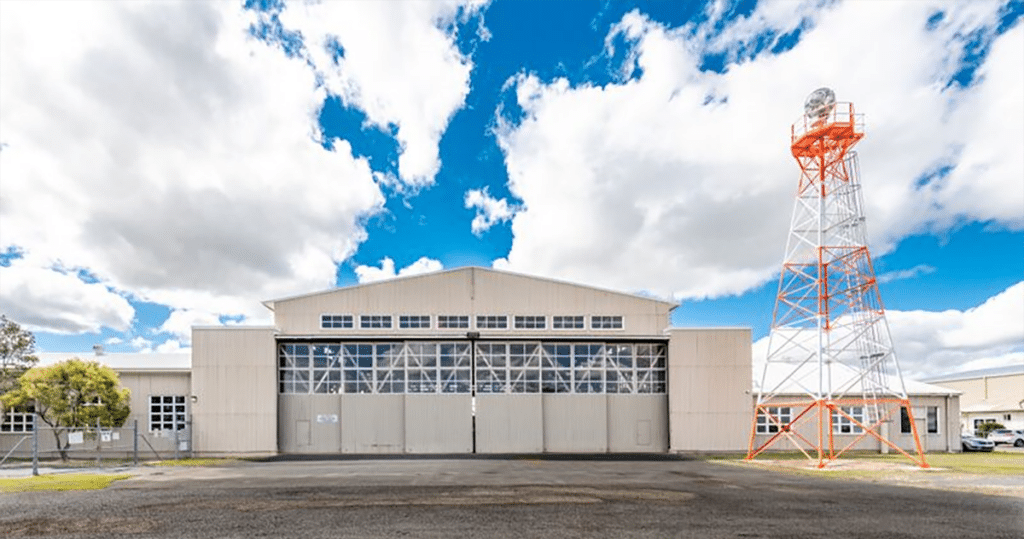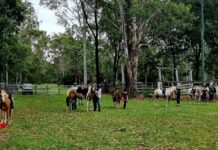
Bundaberg Airport, established in the 1930s as part of an unemployment relief scheme, became an important Royal Australian Air Force (RAAF) facility during World War II.
It was one of 36 bases across Australia that were used for the Empire Air Training Scheme, and the first training schools was established at the airport in 1941.
Facilities constructed by the Allied Works Council included aircraft hangers, workshops, accommodation, aircraft hideouts (hard surfaced areas located away from the main buildings for the dispersal of aircraft if the base was under attack).
Defence structures on the site included machine gun pits and mine charges laid in trenches along runways and some of them remain standing today.
These structures are being recognised as part of Australian Heritage Festival month and the 2024 theme connection which sees Council celebrating the region's link to Bert Hinkler and aviation.
Historic structures still found at Bundaberg Airport
When the airport returned to civilian use in 1946, the RAAF planned to dismantle most of the building constructed during the war.
The disposal was planned to occur in five stages, but the final stage did not proceed, and a number of facilities and concrete slabs from former structures remain on the airport site to this day.
The remaining World War II features at the airport are listed on Bundaberg Regional Council’s Local Heritage Places Place Card.
The buildings still standing are the former Quarter, Station Headquarters, Garage, Workshop and Store, and Inflammables Store.
The slab for Bellman Hangers, early drainage infrastructure and some of the defensive sites also remain, including possible machine gun pits and sections of blast wall embankments.
Hangar among Bundaberg Airport WWII notable buildings
The most prominent is the hangar and workshop building a short distance southeast of the airport terminal, and which is still used as a hangar and aviation workshop.
It is a 22-23 m clear span hardwood timber Pratt truss hangar, with bolts and shear connectors and is likely to have been constructed of green timber.
Internally, the main body of the clear-span hangar consists of an open space with concrete floors.
Long, narrow rectangular windows are arranged along the length of the hangar, directly below the roof line.
The main space is characterised by the intricate timber truss system which forms the framework of the hangar.
Inflammable Store
The former Inflammable Store is a small rectangular gable-roofed building clad in vertical corrugated iron sheets with corrugated asbestos cement roof sheeting and metal ventilation ducts on the roof.
It resembles other World War II buildings that were on the site and later removed to be used for the Hinkler Flight School and Bundaberg Aero club buildings.
The Inflammables Store currently houses the electricity sub-station for the airport, including electrical boxes and a back-up generator.
Garage remains in use
The former Garage consists of a flat roofed timber framed building, externally clad in vertical corrugated iron sheets.
The doors are clad with modern steel sheeting of in-set wide panels and the flat roof with corrugated iron.
Internally, the Garage is divided into 12 bays by cross-bracing only and includes an office and other lockable storage areas at its western end, which are still utilised for their original purpose.
The floors of the western bays are concrete and include an inspection pit, and the eastern bays have a dirt floor.
There are several built-in timber cabinets and workshop shelves, which are potentially from World War II.
The former Motor Transport Garage is still used as a vehicle service and maintenance area but represents only around one third of the original Bundaberg Airport WWII structure, with only the foundations of the eastern portion of the building remaining.
Archaeological study confirms Bundaberg Airport WWII runway link
A previous archaeological study determined that the present day location of the runways and taxiways generally correspond with those used during World War II.
Airport Defences including a possible machine gun pit, consisting of a circular, excavated pit measuring approximately 4 m in diameter and 1.5 to 2 m in depth, are situated southeast of the southern end of the runway.
The airside area west of the hangar and workshop building incorporates sections of at least 6 Bellman Hangar slabs and the footprints of at least 3 flight line buildings.
A former hutted accommodation area, Parade Ground area and original drainage systems were also identified in the study.
Though Bundaberg was not heavily utilised during WWII, the presence of these structures at the Bundaberg Airport are an ongoing reminder of the region’s important role during the war.
Other news: Hinkler House celebrated during heritage festival







